 |
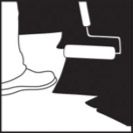 Seal the Deal
Seal the Deal
ChemMasters Newsletter: Vol 3 Issue 2
Spring Re-Sealing
Warming temperatures are a welcome sign of spring. But the melting snow always reveals a long list of projects that require our effort and attention so we can maximize the enjoyment of our outdoor spaces during warm weather months. Many of those projects are annual lawn and landscaping jobs; planting annuals, fertilizing & weeding the lawn, mulching the beds, etc. But each year our structural elements require attention as well.
Re-sealing concrete has some unique challenges, particularly if there is an existing sealer still present. In this article we will explore the best practices associated with cleaning your concrete and choosing an appropriate ChemMasters product to re-seal your previously sealed concrete.
Cleaning Broom Finished Concrete
Broom finished driveways, patios and sidewalks will have accumulated a fair amount of dirt and debris over the winter months. A good power washing will remove those surface contaminants and allow you to assess whether any further attention is required. Use a 2,500 psi power washer with a fan tip, maintaining an 8-12” distance from the concrete surface to avoid causing damage.
Power washing will also remove any unsound sealer or concrete that may have been damaged over the winter due to freeze/thaw cycles and/or use of deicing chemicals. ChemMasters manufactures several cementitious repair mortars if the damage is significant. Products such as ChemMix and FeatherPatch may be good choices, keeping in mind that neither product is a thin re-surfacer.
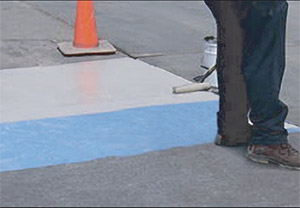
Polyseal Tints can help hide repairs.
Tech Tip
Use of a film forming sealer with added opaque pigment such as Polyseal Tint (for solvent-based sealers) or Polyseal WB Tint (for water-based sealers) can help hide those repairs under a pigmented coating. ChemMasters offers a variety of available tint colors to suit your aesthetic preferences.
Resealing Broom Finished Concrete
Film forming sealers are impacted by the previous summer’s exposure to UV sunlight that may result in micro-cracking of the sealer, resulting in a dull, weathered appearance. They can be further damaged by winter freeze/thaw cycles and the use of deicing chemicals.
Choosing a product for re-sealing will in part depend upon whether your concrete has been previously sealed, what it was sealed with, and how much remains. In general, sealers come in two types; film forming coatings that reside on the surface of concrete and penetrating treatments that reside within the concrete. If your concrete has previously been treated with a film forming coating and some of it is still intact, you will be limited to using another film former to reseal since the existing coating would prevent absorption of a penetrating treatment. If the previous sealer was a penetrating treatment, you have the option of re-sealing with another penetrating sealer, or using a solvent-based film forming sealer.
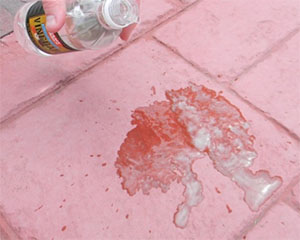
If household vinegar foams, no film forming sealer is present.
Tech Tip
Identifying the existence of a film forming sealer can be done three ways.
- Visual confirmation of a film forming sealer on the concrete surface.
- Water does not readily absorb into the concrete.
- A small puddle of household vinegar does not foam or bubble.

If water readily absorbs, no penetrating sealer is present.
Tech Tip
Identifying the existence of a penetrating sealer can be accomplished two ways.
- Place a drop of water on the concrete surface and check for absorption.
- Does the water droplet maintain a rounded "contact angle" on the concrete surface (like a bubble).
Do not assume your broom finished concrete needs to be re-sealed! Over use of film forming sealers can result in bubbling and whitening of the coating, while over use of penetrating sealers is ineffective. If your use of a sealer is for concrete protection, the best time of year to apply both a film forming or penetrating sealer is early fall since concrete is damaged by freeze/thaw cycles and deicing chemicals, not exposure to sunlight.
Other differences between film forming and penetrating sealers include:
- Aesthetics - Penetrating sealers do not alter the appearance of concrete, while film forming sealers will cause darkening, impart gloss, and can be used with decorative pigments.
- Ease of Use – Penetrating sealers are much more user friendly. Improperly applied film forming sealers can result in roller/sprayer marks, bubbling, whitening, peeling, delamination, etc.
- Durability – Penetrating sealers offer the best, longest lasting protection against damage caused by freeze/thaw cycles and deicing chemicals.
- Stain Protection – Penetrating sealers do not provide any protection from stains caused by spills and contaminants.
Film Forming Sealer Choices
Film forming sealers are available in two different chemistries; solvent-based and water-based. They differ in a few ways:
- Aesthetics - Solvent-based film forming sealers will darken concrete and generally give a high gloss appearance. Water-based sealers will leave concrete much lighter, with low to medium gloss.
- Ease of Use – Solvent-based sealers (particularly low-VOC versions) can be tricky to use in hot, windy weather and can be more susceptible to over application resulting in bubbling and/or whitening. Water-based sealers are more difficult to use in low temperatures that may cause improper film formation.
- Durability – Water-based sealers generally have a little better resistance to common household chemicals.
- Stain Protection – Both water and solvent-based sealers provide moderate protection from stains caused by spills and contaminants.
Popular solvent-based film forming sealers for use on broom finished concrete include:
Low-VOC Solvent-Based Versions
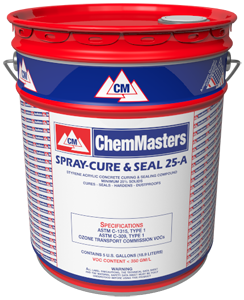 Spray-Cure & Seal 25-A
Spray-Cure & Seal 25-A
Low-VOC Styrenated Acrylic Cure & Seal
for Broom-Finished Concrete
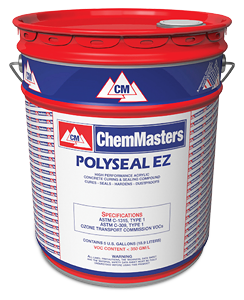 PolySeal EZ
PolySeal EZ
Bubble Resistant Low-VOC Cure and Seal
resists bubble formation, cobwebbing, and stringing
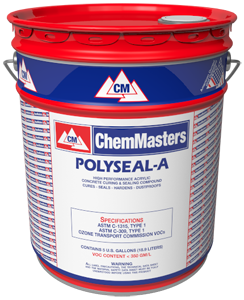 PolySeal-A
PolySeal-A
Low_VOC Pure Acrylic Concrete Cure and Seal
high solids, high-performance, resists discoloration
High-VOC Solvent-Based Versions
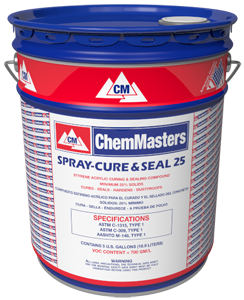 Spray-Cure & Seal 25
Spray-Cure & Seal 25
Styrenated Acrylic Cure & Seal
for Broom-Finished Concrete
 PolySeal
PolySeal
Pure Acrylic Concrete Cure and Seal
high solids, high performance
Water-Based Versions:
 Safe-Cure & Seal 309
Safe-Cure & Seal 309
Economical Indoor Concrete Cure & Seal
water emulsion, styrene acrylate copolymer compound
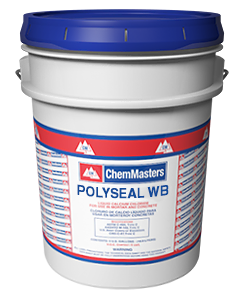 Polyseal WB
Polyseal WB
Pure Acrylic Non-Yellowing
concrete cure and seal
Penetrating Sealer Choices
Penetrating sealers are also available in solvent-based and water-based versions.
- Aesthetics - Penetrating sealers do not change the appearance of concrete, and cannot be pigmented.
- Ease of Use – Penetrating sealers are very user friendly and forgiving.
- Durability – Because penetrating sealers reside within the concrete and do not wear, they provide longer lasting protection from freeze/thaw and deicing chemical damage.
- Stain Protection – Penetrating sealers do not offer stain protection from surface spills and contaminants.
Popular penetrating sealers for use on broom finished concrete include:
Low-VOC Solvent-Based Versions
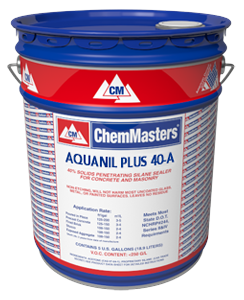 Aquanil Plus 40-A
Aquanil Plus 40-A
Low-VOC Solvent Based, Penetrating
Silane Sealer for Concrete and Masonry
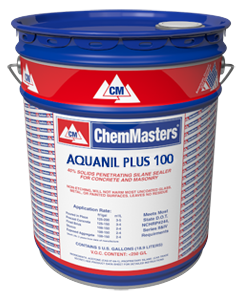 Aquanil Plus 100
Aquanil Plus 100
Penetrating Silane Sealer
for Concrete and Masonry
High-VOC Solvent-Based Versions
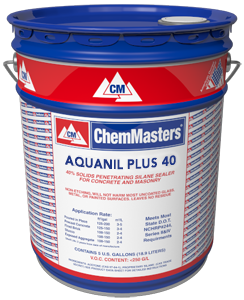 Aquanil Plus 40
Aquanil Plus 40
Penetrating Silane Concrete Sealer
and Waterproofer
Water-Based Versions:
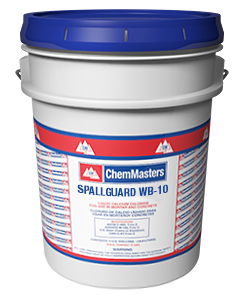 SpallGuard WB-10
SpallGuard WB-10
Penetrating Siloxane Low-VOC
Water-Based Concrete Sealer & Waterproofer
Cleaning Decorative Concrete
Cleaning stamped, exposed aggregate and other decorative concrete driveways, patios and sidewalks is much the same as cleaning broom finished concrete. However, extra care should be used to ensure cleaning does not damage the decorative finish/surface.
A good power washing will remove those surface contaminants and allow you to assess whether any further attention is required. Use a 2,500 psi power washer with a fan tip, maintaining an 8-12” distance from the concrete surface to avoid causing damage.
Resealing Decorative Concrete
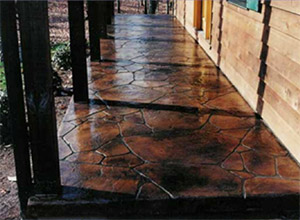
Solvent-based film forming sealers deepen color and achieve high gloss finishes.
Decorative concrete differs from broom finished or smooth troweled concrete in many ways, some of which impact the frequency of resealing and the choice of sealers. Whereas broom finished concrete is primarily sealed in order to protect it from freeze/thaw and deicing chemical damage, decorative concrete is primarily sealed for its aesthetic qualities.
Decorative concrete sealers will darken concrete giving it a “wet look”, while developing the color of decorative stains, dyes and antiquing release agents. In most cases a high gloss appearance is also desired. That means decorative concrete isn’t resealed when the sealer has worn away… it’s resealed when the gloss and color development have diminished.
Decorative Concrete Sealer Choices
Because darkening, color development and gloss are only associated with film forming sealers, decorative concrete is almost never sealed with penetrating sealers. And since those same qualities are most pronounced with solvent-based sealers (as opposed to water-based), they are by far the predominant choice to seal decorative concrete.

Gloss Restorer SRT restores gloss to dull, weathered sealers without reducing breathability.
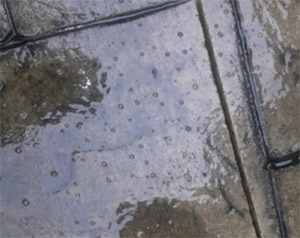
Over application of decorative sealers can result in bubbling, whitening or even delamination.
Tech Tip
Because decorative concrete is sealed more frequently, the increased coating thickness can reduce its ability to “breath”, resulting in in bubbling, whitening or even delamination. Consider using one of ChemMasters specialty decorative sealers to avoid resealing problems:
Gloss Restorer SRT
Polyseal EZ
Stamped & Decorative 400-A
Tech Tip
Do not over apply decorative sealers. Less is better. Do not assume your concrete needs to be resealed annually.
ChemMasters offers a wide variety of high performance decorative concrete sealers. Each is specially formulated for their ability to both enhance the aesthetic qualities of decorative concrete, and provide long-term protection of your investment.
Popular solvent-based film forming sealers for use on decorative concrete include:
Low-VOC Solvent-Based Versions
 PolySeal EZ
PolySeal EZ
Bubble Resistant Low-VOC Cure and Seal
resists bubble formation, cobwebbing, and stringing
 PolySeal-A
PolySeal-A
Low_VOC Pure Acrylic Concrete Cure and Seal
high solids, high-performance, resists discoloration
 Traz 25-A
Traz 25-A
Low-VOC Solvent-Based
Methyl-Methacrylate Concrete Sealer
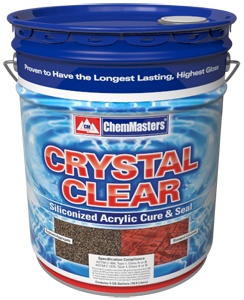 Crystal Clear-A
Crystal Clear-A
Siliconized Acrylic Concrete Cure & Seal
super high gloss, non-yellowing compound
 Stamped & Decorative Sealer 400-A
Stamped & Decorative Sealer 400-A
Slow Evaporating, Low-VOC
High Gloss "Wet Look" Sealer
PolySeal-PlusA
High Performance, Low VOC, Solvent Based
Acrylic Curing and Sealing Compound
High-VOC Solvent-Based Versions
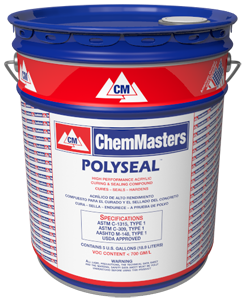 PolySeal
PolySeal
Pure Acrylic Concrete Cure and Seal
high solids, high-performance, resists discoloration
PolySeal Plus
High Performance Curing And Sealing Compound
non-yellowing, high gloss
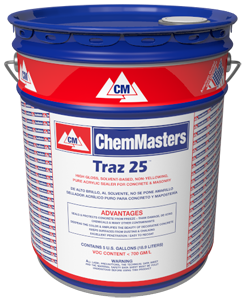 Traz 25
Traz 25
Methyl-Methacrylate Concrete SealerSolvent-Based
high-gloss, chemical-resistant
 Crystal Clear
Crystal Clear
Low-VOC Siliconized Acrylic Concrete Cure & Seal
super high gloss, non-yellowing compound
Water-Based Versions:
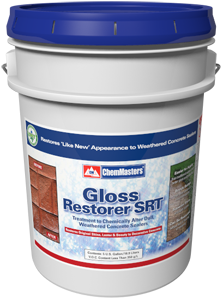 Gloss Restorer SRT
Gloss Restorer SRT
Restores Gloss
to Dull Weathered Sealers
Access a wide selection of Tech Tips and FAQ’s online at ChemMasters University.
Silencure, Polyseal, Traz, Aquanil, Spall Guard, Chemisil, EZ Strip Cure, SafeSeal, Spray Film, DuraShield SRT, Slip Stop and Exposee are trademarks of ChemMasters, Inc. ChemMasters and Safe-Cure are registered trademarks of ChemMasters, Inc.
300 Edwards Street, Madison, Ohio 44057
Phone 440.428.2105 - 800.486.7866
Fax 440.428.7091
Silencure, Polyseal, Traz, Aquanil, Spall Guard, Chemisil, EZ Strip Cure, SafeSeal, Spray Film, DuraShield SRT, Slip Stop and Exposee are trademarks of ChemMasters, Inc. ChemMasters and Safe-Cure are registered trademarks of ChemMasters, Inc.

Phone 440.428.2105 - 800.486.7866
Fax 440.428.7091
ERISA Documents for Welfare Benefit Plan
